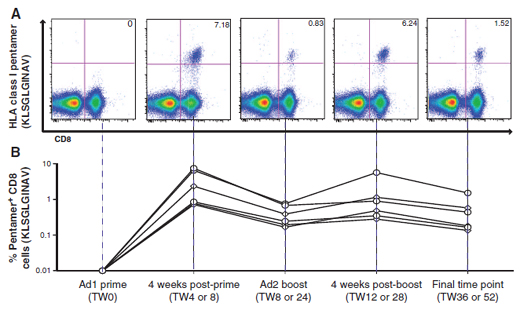Your basket is currently empty!
Success for Hepatitis
Success for Hepatitis C Vaccine Trials at Oxford University
Novel Adenovirus-Based Vaccines Induce Broad and Sustained T Cell Responses to HCV in Man.
Barnes, E. et al. (2012). Novel Adenovirus-Based Vaccines Induce Broad and Sustained T Cell Responses to HCV in Man. Science Transitional Medicine. 4(115):115ra1. [PubMed ID 22218690]
| Infection with Hepatitis C virus (HCV) can cause debilitating liver disease, and up to 170 million people worldwide carry the virus. Infected individuals will often be asymptomatic for years, so rather than waiting for HCV patients to present with liver disease, researchers are trying to develop a preventative vaccine. |  |
In a recent edition of Science Translational Medicine, Oxford University researchers reported the first clinical trial of a preventative vaccine for HCV based on T cell activation.
Ellie Barnes, Paul Klenerman and their colleagues tested a vaccine designed to elicit a long-lived anti-HCV response from CD4+ and CD8+ T cells.
They worked with adenovirus to provide a sturdy vector for expressing portions of viral proteins. However, most people have at one stage or another been exposed to adenovirus, and will clear the virus before it can start to be effective as a vaccine. To overcome this hurdle, the team developed two different adenoviral vectors based on a rare human adeonovirus (Ad6) and a chimpanzee adenovirus (ChAd3).
It was important to avoid parts of the virus that mutate quickly, such as the viral coat, so Barnes et al used targets from the viral innards: non-structural proteins 3, 4 and 5. Regions (‘epitopes’) from these proteins had been characterized as important in immune responses from individuals who had managed to spontaneously clear HCV infection.
The responses from vaccinated individuals were very closely monitored. One aspect of this was monitoring the exact viral epitopes being targeted by the two vaccines. Over the course of the study (up to 52 weeks) the percentage of circulating CD8+ T cells staining with ProImmune’s Pro5® MHC Class I A*02:01/KLSALGINAV or A*01:01/ATDALMTGY HCV NS3 Pentamers in each individual were tracked. The data accumulated clearly showed that the CD8+ T cell response went from barely detectable to a sustained 1% of the CD8+ T cell population, an impressive result.

Figure 1: Characterization of epitope-specific T cell responses induced after vaccination with either of the two test vaccines. (A) Staining with A*02:01/KLSGLGINAV Pro5® Pentamer in a representative subject over the study time course. Gating is on live CD3+ T cells. Percentage pentamer+/CD8+ T cells are shown. (B) Ex vivo tetramer+ CD8+ T cell responses over time in six volunteers who responded to the vaccination. Figure reproduced with permission from Science Translational Medicine.
Overall, the anti-HCV responses induced in the trial subjects were prolonged, and broad in terms of the epitopes they targeted. This is important because it should allow the vaccine to work against different HCV strains, and to remain effective even if some of the targets mutate over time.
Speaking to BBC News just after the work was published, Paul Klenerman was optimistic about the promise of his results, stating “The immune responses we’ve seen are exciting”.
